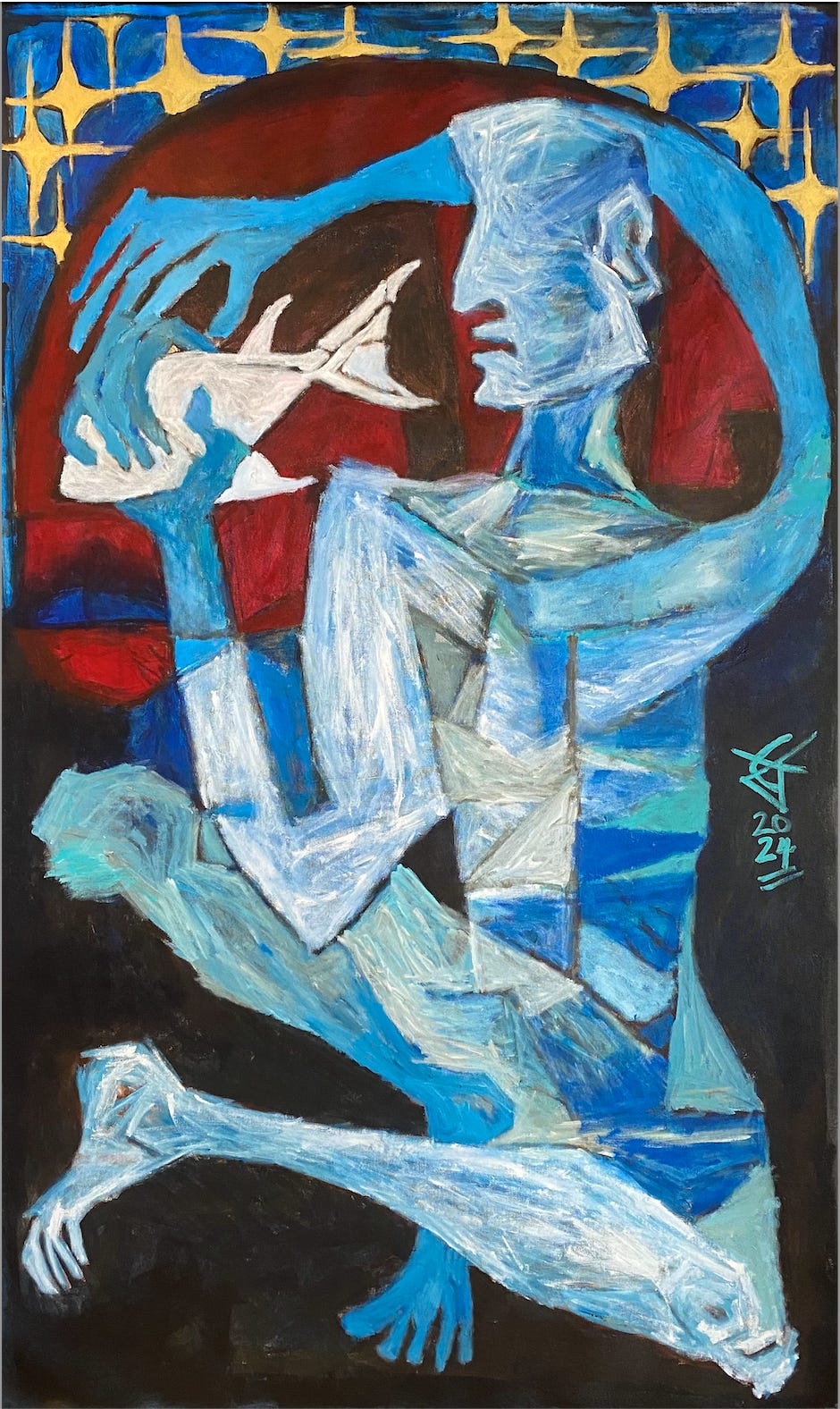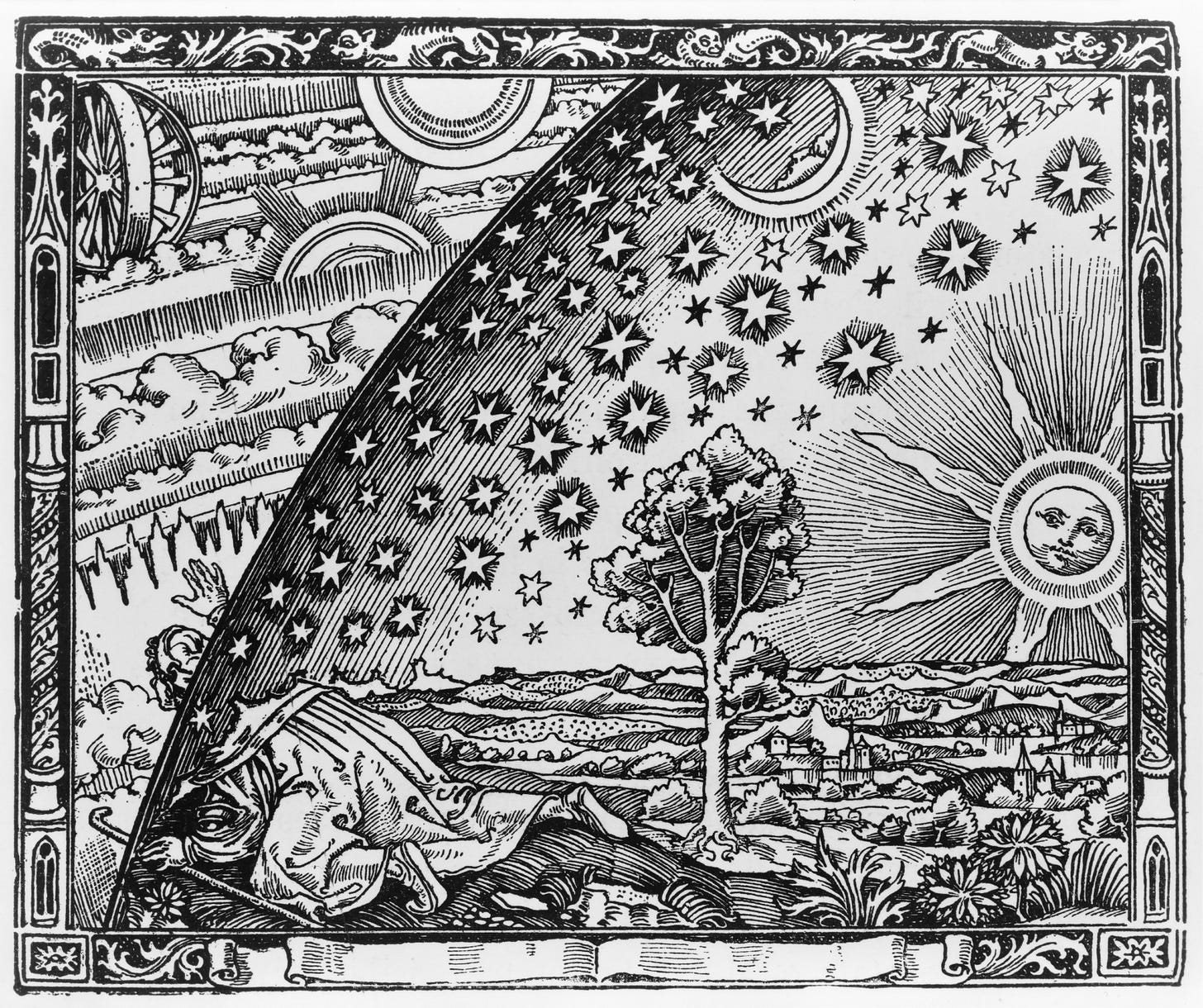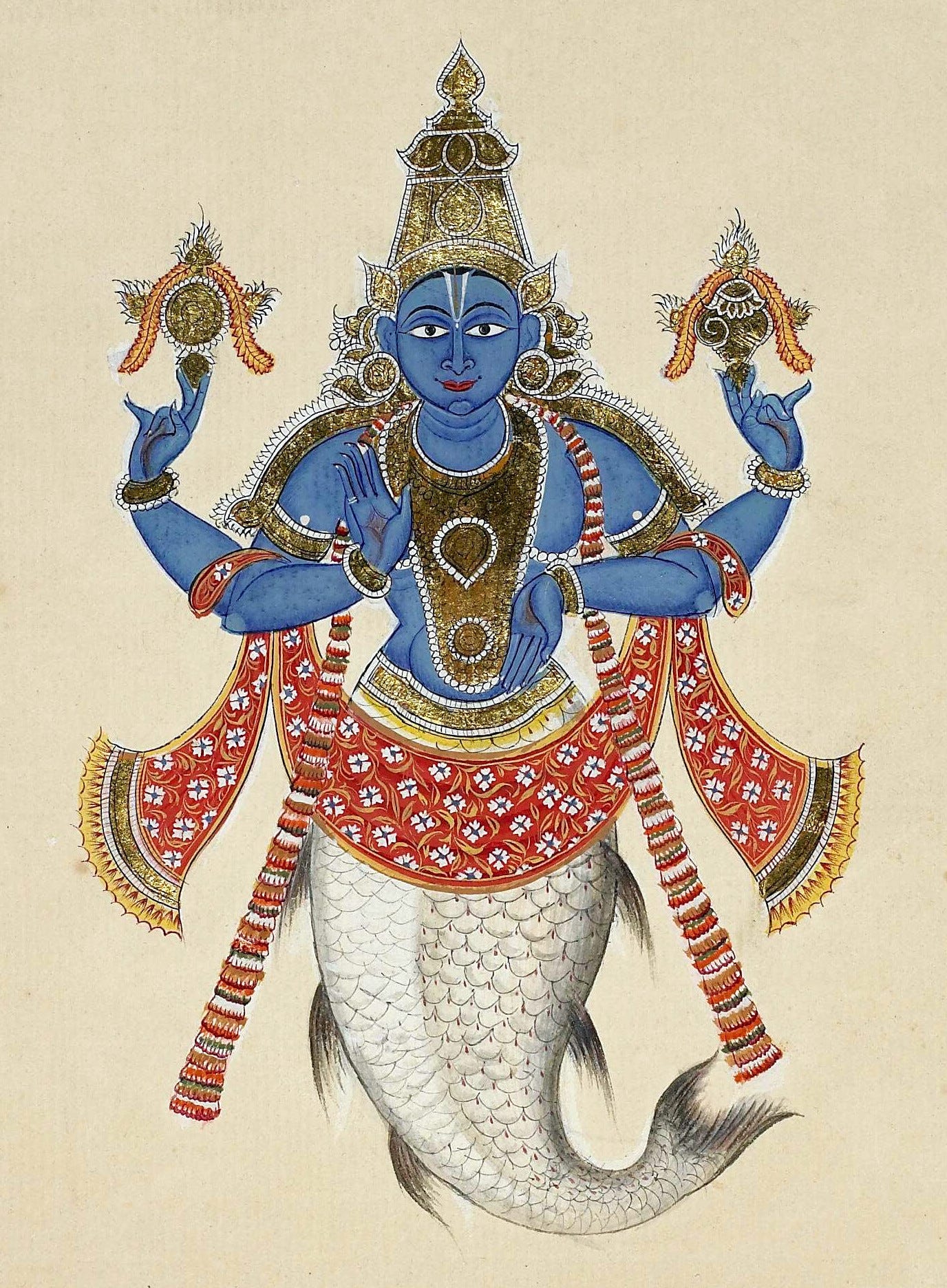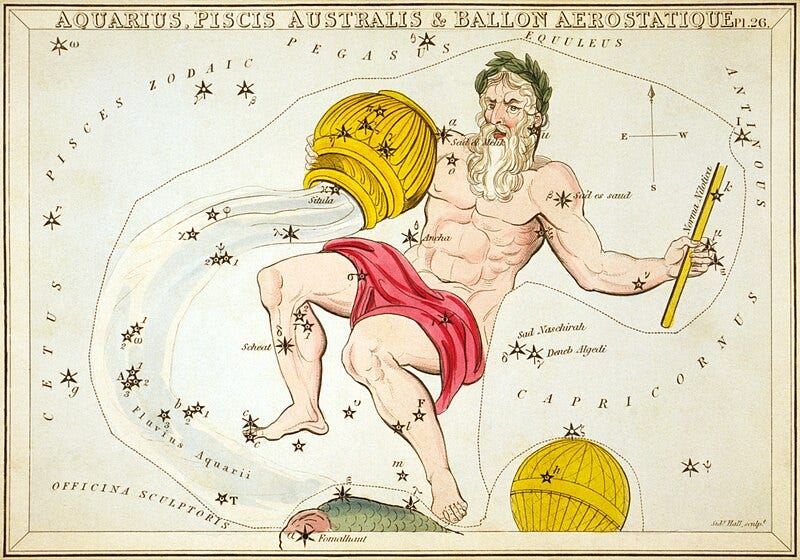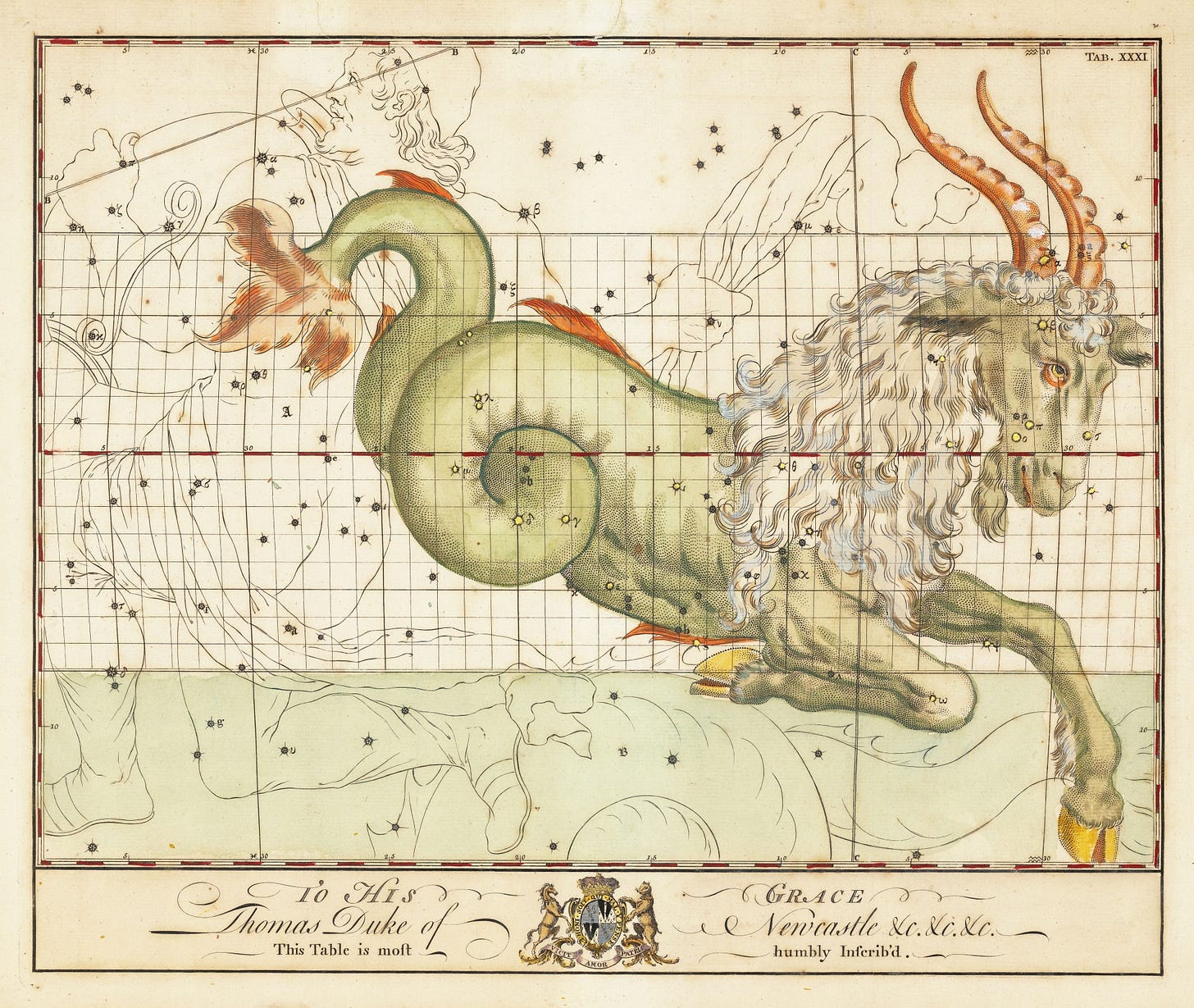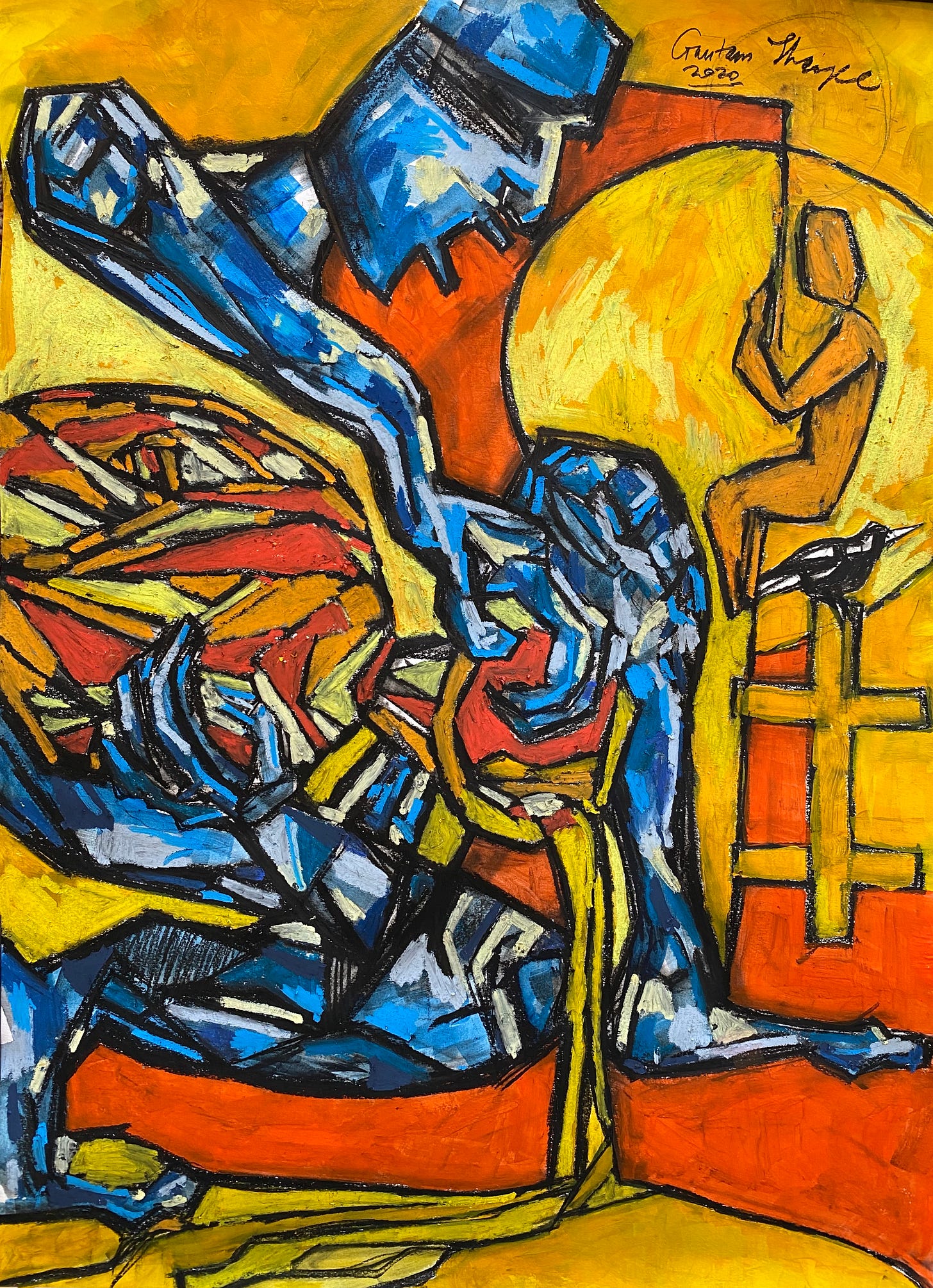Fish Symbolism, The Zodiac, Carl Jung and the Development of Human Consciousness
Welcome to my Newsletter, 9th June 2024
I had a dream on the night of 18th November last year of ocean fishing by hand. The dream images lent themselves to a large painting of the scene, “The White Fish”. I explore the painting’s symbolism in this newsletter article, which can be taken as an art-based case study in Jungian dream analysis.
The White Fish, Acrylic and Metallic Paint on Indian Canvas, 178H x 107W cm, 2024
The Dream of The White Fish
"The fish symbol is one of the oldest representations of the unconscious." - Carl Jung (1951) in Aion: Researches into the Phenomenology of the Self.
I have been recording my dreams for about 6 years now since I was 37 years old and have been analysing them from a Jungian perspective. I carry out dream analysis because dreams contain valuable messages from the unconscious psyche - why Carl Jung saw dreams as ‘gifts from nature’. In this respect, understanding one’s dreams is enormously beneficial, especially when dream images are brought to life via art.
The painting shows the central scene from my dream, where a male figure (myself, the dreamer), holds a freshly caught, white fish. In contrast to the white of the fish, the depths of the sea in which the figure swims are dark and impenetrable, absorbing all light, revealing nothing of the vast, mysterious ocean. The figure is contained in a dome, or ‘firmament’, with stars across a magical sky beyond the confines of the dome.
Here’s an account of the dream as recorded in my dream diary:
“I was fishing in the sea with someone else. Another guy. At one point we go fishing in what we call ‘Hong Kong' style, where you jump into the sea and go under an upturned bowl resembling the firmament. Then dive down to catch fish by hand. I was too uncomfortable with the ocean to do this so my partner caught the fish by hand in seconds whilst I stayed in the upturned bowl. The fish was white and about 8 inches long. I was surprised that he’d killed it so quickly.” - night of 18th November 2023
A full, detailed dream analysis and interpretation would be beyond the scope of this newsletter (as much as I would love to include it). In short, the dream indicates that something unconscious - whatever is symbolised by the white fish - has been brought ‘above the surface’ to conscious awareness.
This was achieved with the help of the other male figure in the dream - for those familiar with Jungian psychology, this is most likely a manifestation of the ‘Jungian Shadow’, a personification of the unconscious parts of oneself that have been rejected, repressed or otherwise kept from consciousness. This Shadow figure can be enormously helpful in furthering psychological development and often manifests in dreams as an opposite ‘counterpart’ to the dreamer, and of the same gender (I did not paint the Shadow).
The ego - always represented by the dreamer in dreams - is naturally uncomfortable in the unconscious, represented by the sea. However, the Shadow figure is highly adept in the waters of the unconscious and catches fish with ease so that the ego may ‘eat of the sea’. Jung argued that recovering and integrating (ingesting) unconscious elements had a nourishing effect on the psyche.
The Firmament, represented by the upturned basket is a powerful symbol that references The Book of Genesis in the Old Testament, and the famous Flammarion engraving, shown below. I have been fascinated by this image for many years because it shows a figure breaking out of a domain of seemingly mundane experience and looking into a magical cosmos beyond. It has been an important image in the tradition of western alchemy and its deeper meaning relates to a significant expansion of consciousness. Unlike the man in the Flammarion engraving, I do not look through the firmament in my dream, though I have represented the realm beyond with gold stars at the top of the painting.
Camille Flammarion, L'Atmosphère: Météorologie Populaire (Paris, 1888), pp. 163. (Wikipedia: Public domain)
The Firmament as a symbol also evokes another significant association - that of the ‘Magian Cavern’ or ‘Crypt’, as described in Oswald Spengler’s 1918 and 1922 two volume masterwork, “Der Untergang des Abendlandes” (known in English as, “The Decline of the West”). This dome form is a mystical, deeply sacred and inward looking space that is the architectural expression of a civilisation focused on introspection, and a particular study of dualistic opposites (e.g. Good and Evil, Light and Dark). Spengler’s assertion is that all civilisations are born of a single central idea or ‘Prime symbol’ and that every facet of that civilisation is an expression of that Prime Symbol. Magian Civilisation, encompassing the cultures of the Near and Middle East over a particular period of time, abounds with domed shaped sacred architecture - I used dark tones and deep reds for the inside of the dome in my painting to evoke this.
The Fish and Humanity’s Evolving Collective Unconscious
Jung wrote that, "The fish is a symbol of the living content which lies hidden in the unconscious and which when released brings renewal and rebirth" (The Archetypes and the Collective Unconscious, p.151, 1959). Religion, mythology and culture abound with fish symbolism.
Here are some examples that I find especially interesting. Jonah and his three days and three nights in the belly of the whale. Christ as ‘Ichthus’ and Simon Peter, the fisherman. The Hindu God, Matsya (pictured below), the first Avatar of Vishnu. The ‘Book of Tobit’, where Tobias and the archangel Raphael catch a fish in the Tigris - its gall has healing powers that cure Tobit of blindness. Pinocchio’s and Geppetto’s release from the belly of The Terrible Dogfish as the pivotal moment in the final humanisation of the wooden puppet-boy. One might also consider Herman Melville’s Moby Dick (1851), where the mighty whale eventually overpowers Captain Ahab. Moby Dick is a cautionary tale, where taken symbolically, the recovered unconscious content is too powerful for our protagonist’s ego resulting in oblivion.
Painting of Matsya, the fish-incarnation of Viṣṇu. The upper body of Viṣṇu emerges from the body of the fish. A silk sash is draped over his elbows and has an intricate design. On laid and water-marked European paper, dated 1816. (Wikipedia: Public domain).
There are many other examples but the fish in my dream has resonance for me with a specific aspect of its symbolism - the wider story of human consciousness over very long periods of time. Jungian literature, namely Aion, looks at the zodiac and its signs as a sort of collective dream that foretells the evolution of consciousness.
Jung drew parallels in Aion between Christ’s association with the fish symbol and the beginning of the Piscean Age, as characterised by the ‘Sign of the Fishes’ (Jung saw the birth of Christ and the advent of the Piscean Age as synchronous). Each zodiacal sign reflected a developmental stage lasting a Platonic Month (approximately 2000 years). The constellation Pisces comprises two fishes in opposing orientation to each other.
For Jung, the two fishes denoted Christ and his symbolic opposite, hinting at a collective struggle between opposing forces as a stage in the development of collective human consciousness. According to Jung, whilst the age of the first fish is linked to Christ, the age of the second fish had its birth with the emergence of the myth of Dr Faustus around the time of the Renaissance and the Reformation in the 16th Century1. This confrontation between these opposites is today reaching its climax as the age of Pisces draws to its end.
A cord joins the tails of Pisces, the two fishes", from Atlas Coelestis (1729), John Flamsteed (1729). (Wikipedia: GNU Free Documentation License)
Fish also appear in the symbolism of the next two great aeons (4000 years) following the Age of Pisces. Today, we are at the threshold of the Age of Aquarius, symbolised by the Water Bearer pouring water into the mouth of a fish (Piscis Austrinus)2.
Jung wrote in his Autobiography, Memories, Dreams, Reflections (1963): “The Water Bearer seems to represent the self. With a sovereign gesture he pours the contents of his jug into the mouth of Piscis austrinus, which symbolises a son, a still unborn content. Out of this unconscious unborn content will emerge, after the passage of another aeon of more than two thousand years, a future whose features are indicated by the symbol of Capricorn: an aigokeros, the monstrosity of the Goat-Fish, symbolising the mountain and the depths of the sea, a polarity made up of two differentiated animal elements which have grown together. This strange being could easily be the primordial image of a Creator-god confronting “man”, the Anthropos.”
Piscis Austrinus can be seen cut off at the bottom of Urania's Mirror's 1825 depiction of Aquarius. Next to it is the obsolete constellation Ballon Aerostatique (Wikipedia: Public domain).
Capricornus, Sidney Hall, 1825, depicting Aigokeros, The Goat-Fish of Capricorn with the top half of a goat, representing the heights of consciousness, and the bottom half of a fish, representing the unconscious depths (Publicdomainpictures.net).
It is noteworthy that visions of our deep future (many featuring apocalyptic events) seem to abound now in culture and have risen to prominence. Current examples include the brilliant, latest instalment of the Mad Max series of films, ‘Furiosa: A Mad Max Saga’, the visually stunning, two-part ‘Dune’ movie remakes of Frank Herbert’s Sci-Fi epic, and Apple’s ‘Foundation’, based on Issac Asimov’s novels by that name. As the 2020s unfold it is becoming increasingly apparent that we are at a significant juncture in history.
References
Jung, C. G. (1951). Aion: Researches into the Phenomenology of the Self (R. F. C. Hull, Trans.). Routledge & Kegan Paul.
Jung, C. G. (1959). The Archetypes and the Collective Unconscious (R. F. C. Hull, Trans.). Princeton, NJ: Princeton University Press. (Original work published 1954)
Jung, C. G. (1970). Mysterium Coniunctionis: An Inquiry into the Separation and Synthesis of Psychic Opposites in Alchemy (R. F. C. Hull, Trans.). Princeton University Press.
Jung, C. G. (1963). Memories, Dreams, Reflections (A. Jaffe, Ed.; R. Winston & C. Winston, Trans.). Vintage Books.
Spengler, O. (1965). The Decline of the West (H. Werner, Ed.; C. F. Atkinson, Trans.). New York: Modern Library.
There’s a wonderful recording on Youtube of a lecture given by Edward Edinger in 1988 on the development of the Piscean Age and the symbolism of the Fish. For those interested I’ve include the link below. Edinger is one of my favourite interpreters of Jung, especially on this subject - this is well worth listening to.
My 2020 oil pastel, charcoal and acrylic piece on Italian paper of the Aquarian Water Bearer (50 x 70 cm)
pouring water into the steam of life. I created this for an exhibition at Palliative Care Australia. Here’s the text accompanying the piece in the exhibition:
“The term ‘palliative care’ is typically associated with death and endings; two inevitabilities of life broadly tabooed in modern times. Ancient traditions, however, have embraced life’s stages, including death, as natural transformations. Carl Jung, whilst studying our collective human heritage suggested that physical death is not the end: “The unconscious psyche believes in life after death”. My entry is based on archetypical symbols of transformative new beginnings: The Water Bearer, whose flow washes away the old so the new can take seed, the child as a symbol of new life, the sun and intersecting crosses evoking totality and wholeness.”




